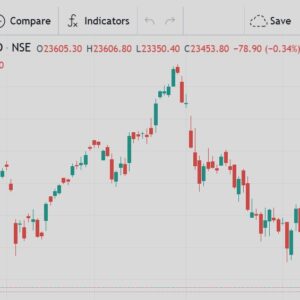What is Nifty 50? A Comprehensive Guide to Understanding India’s Benchmark Stock Index

The Nifty 50, India’s premier stock market index, serves as a barometer for the performance and stability of the Indian equity market. As a compilation of the top 50 companies listed on the National Stock Exchange (NSE), Nifty 50 provides insight into the economic health of the country. For investors and financial analysts, understanding the intricacies of Nifty 50 is essential for informed investment decisions.
In this article, we delve into the structure, significance, and historical evolution of Nifty 50, examining what makes it a cornerstone of the Indian stock market.
Understanding Nifty 50: What Does It Represent?
The Nifty 50 Index represents the weighted average of the top 50 companies across various sectors listed on the National Stock Exchange of India (NSE). These companies span across industries like finance, IT, pharmaceuticals, consumer goods, and energy. Nifty 50 is often seen as a snapshot of the Indian economy’s performance and, by extension, its growth trajectory.
As a market capitalization-weighted index, Nifty 50 prioritizes companies with larger market values, giving them a greater influence on the index’s movement. This method allows the index to reflect the actual market value of the leading businesses, providing a balanced and reliable gauge of market sentiment.
Why is Nifty 50 Important for Investors?
The Nifty 50 is not only an indicator of market performance but also serves as a benchmark for mutual funds, ETFs, and other investment vehicles. Institutional and retail investors alike track the Nifty 50 closely, using it to gauge the economic environment and adjust their portfolios accordingly.
1. Portfolio Diversification and Risk Management
By investing in Nifty 50-based funds, investors achieve instant diversification across 13 distinct sectors, mitigating risk associated with individual stocks or sectors. This diversified exposure makes Nifty 50 an attractive choice for both conservative and aggressive investors.
2. Indicator of Economic Health
Since Nifty 50 covers companies across various industries, its performance mirrors the broader economic landscape. A strong upward trend in Nifty 50 signals positive economic growth, while a decline may indicate economic concerns. As such, it serves as a reliable indicator of economic health for policymakers and analysts alike.
3. Benchmark for Investment Performance
For mutual funds and institutional investors, Nifty 50 is used as a benchmark index to evaluate fund performance. Funds that outperform Nifty 50 are often considered to be providing higher-than-average returns, making it a useful reference point for fund managers and investors assessing fund efficacy.
Composition and Structure of Nifty 50
Nifty 50’s composition spans multiple sectors, with weightage assigned according to each company’s market capitalization. This structure ensures that companies with larger market values have a greater impact on the index’s overall movement. The sectors with the highest representation typically include financial services, information technology, consumer goods, and energy.
Sectoral Weightage of Nifty 50
- Financial Services: Given the prominence of banking and finance in the Indian economy, financial services hold a significant weightage in the Nifty 50.
- Information Technology: Indian IT giants contribute heavily to the index, reflecting India’s growing digital economy and global IT influence.
- Consumer Goods: With India’s large and diverse consumer base, consumer goods companies play a pivotal role.
- Pharmaceuticals and Energy: These sectors ensure balanced representation of essential industries, stabilizing the index during economic fluctuations.
This sectoral diversity makes Nifty 50 a well-rounded representation of the Indian market, sensitive to shifts in each sector, yet resilient to the downturns of individual companies.
Eligibility Criteria for Companies Listed on Nifty 50
Not every company listed on the NSE can make it to the Nifty 50. To be part of this prestigious index, a company must meet stringent criteria, ensuring that only the most stable and profitable companies are represented.
1. Liquidity Requirements
Companies must maintain a high level of liquidity, ensuring that their stocks can be easily bought and sold. This liquidity ensures that Nifty 50 reflects real-time changes in the market.
2. Market Capitalization Threshold
Only companies with a significant market capitalization are considered. This threshold is crucial to keep the index representative of large-scale, stable businesses that have a considerable impact on the economy.
3. Free-Float Market Capitalization
Nifty 50 uses free-float market capitalization, which considers only the shares available for public trading and excludes promoter holdings. This approach helps ensure that the index reflects the public’s perception of company performance.
How Nifty 50 is Calculated
The Nifty 50 Index is calculated using the free-float market capitalization-weighted methodology. The index value changes according to the collective stock prices of the companies listed in it. This calculation method ensures that changes in market values are proportionally represented, giving investors an accurate picture of market shifts.
- Index Value Calculation: The Nifty 50 index value is computed by dividing the aggregate free-float market capitalization of all the companies by a base value.
- Rebalancing: The composition of Nifty 50 is reviewed semi-annually to ensure it remains aligned with the changing economic landscape and sectoral shifts.
Historical Evolution of Nifty 50
Since its inception in 1996, Nifty 50 has evolved to become India’s most trusted stock market index. The index’s journey reflects the country’s economic growth, industrialization, and transformation into a global economic player. Notably, periods of high growth in Nifty 50 often align with strong economic policies, increased foreign investment, and infrastructure development in India.
- Economic Reforms and Nifty 50: India’s economic liberalization policies have played a major role in the growth of Nifty 50, helping companies expand and attract foreign capital.
- Impact of Technological Advancements: As India emerged as a tech leader, IT companies gained prominence, further solidifying the importance of Nifty 50 as an index that mirrors global business trends.
- Post-Global Financial Crisis Recovery: Following the 2008 financial crisis, Nifty 50 rebounded due to policy reforms and steady domestic demand, showing the index’s resilience and adaptability.
Nifty 50 vs. Sensex: What’s the Difference?
Both Nifty 50 and Sensex are key indicators of the Indian stock market, but they differ in scope and structure. Sensex comprises 30 of the largest companies listed on the Bombay Stock Exchange (BSE), while Nifty 50 includes 50 companies on the NSE.
- Market Coverage: Nifty 50 provides broader market coverage with 50 companies across multiple sectors, compared to Sensex’s 30.
- Index Calculation: Although both indices use market capitalization-weighted methodologies, their calculation bases differ, as they are aligned with their respective exchanges.
- Popularity and Influence: Nifty 50 is widely used as a benchmark by domestic and international investors due to its diversified sector representation.
How to Invest in Nifty 50
Investing in Nifty 50 can be done directly or indirectly, depending on an investor’s preference and risk tolerance. Here are the common investment avenues:
1. Index Funds and ETFs
- Nifty 50 Index Funds: These funds replicate the performance of Nifty 50 by investing in the exact stocks listed in the index, offering a cost-effective and diversified investment option.
- Nifty 50 ETFs: Exchange-Traded Funds track the performance of Nifty 50 and can be bought and sold on the stock exchange, providing flexibility and liquidity.
2. Derivatives Market
- Futures and Options: Traders seeking leveraged exposure to Nifty 50 can participate in the futures and options markets, which allow for speculative or hedging strategies based on the index’s movement.
Advantages of Investing in Nifty 50
Nifty 50 presents several advantages, particularly for long-term investors seeking stability and growth:
1. Diversification
- Nifty 50’s diversified nature mitigates sector-specific risks, offering exposure to a broad range of industries.
2. Stability and Performance
- As Nifty 50 consists of blue-chip stocks with strong fundamentals, it is generally less volatile than individual stocks, offering a stable investment vehicle.
3. Ease of Access
- Nifty 50-based funds are accessible through various mutual funds and ETFs, providing investors an easy and effective way to participate in the market’s growth.
Conclusion
The Nifty 50 Index remains a pivotal instrument in understanding the Indian stock market. With its diversified composition, stringent eligibility criteria, and sectoral representation, it provides an accurate reflection of the Indian economy’s health and future potential. For investors, Nifty 50 is not only a benchmark for portfolio performance but also a reliable pathway for growth and diversification.









